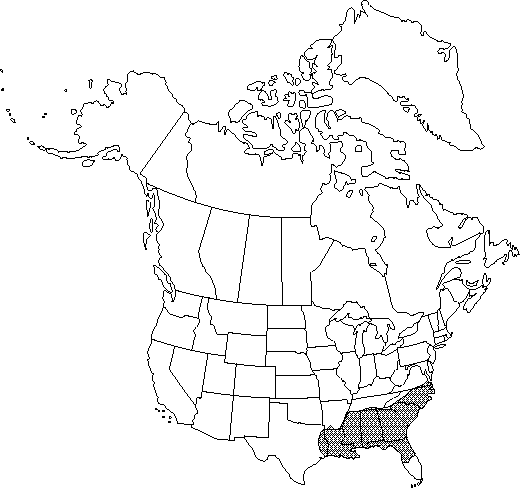Difference between revisions of "Asimina parviflora"
Monogr. Anonac., 82, plate 9. 1817.
imported>Volume Importer |
imported>Volume Importer |
||
| Line 65: | Line 65: | ||
|publication year=1817 | |publication year=1817 | ||
|special status=Endemic | |special status=Endemic | ||
| − | |source xml=https:// | + | |source xml=https://bitbucket.org/aafc-mbb/fna-data-curation/src/2e0870ddd59836b60bcf96646a41e87ea5a5943a/coarse_grained_fna_xml/V3/V3_331.xml |
|genus=Asimina | |genus=Asimina | ||
|species=Asimina parviflora | |species=Asimina parviflora | ||
Latest revision as of 21:47, 5 November 2020
Shrubs or low trees, to 6 m; trunks slender, at most to 10 cm diam. Branches spreading-ascending, slender; new shoots red-brown, distally minutely reddish tomentose. Leaves: petiole 5-10 mm. Leaf blade obovate to oblanceolate, 6-15(-20) cm, membranous, rarely leathery, base narrowly to broadly cuneate, margins barely revolute, apex acute to acuminate; surfaces abaxially minutely rusty-tomentose, aging hairy on veins only, adaxially puberulent on veins, aging glabrous. Inflorescences from previous year's shoots before or during new leaf emergence; peduncle 0.3-0.8 cm, tomentose, hairs red-brown to tan; bracteoles 1(-2), basal, usually ovate-triangular, rarely over 2-3 mm, hairy. Flowers maroon, rarely yellow, faintly fetid, 1-1.7 cm diam.; sepals triangular-deltate, 4-7 mm, abaxially rusty-tomentose; outer petals oblong to ovate, 1-1. 3cm, apex excurved, lingulate, surfaces abaxially minutely rusty-tomentose; inner petals ovate, ca. 1/2 length of outer petals, base saccate, apex strongly recurved, veins adaxially incised, corrugate nectary zone indistinct or absent; pistils 5-7. Berries greenish yellow, 3-6(-7) cm. Seeds chestnut brown, 1-1.5(-2) cm. 2n=18.
Phenology: Flowering early spring.
Habitat: Sands, sandy loams, or sandy alluvium of rich woods, alluvial terraces, and upland dry woods
Elevation: 0-700m
Distribution

Ala., Ark., Fla., Ga., La., Miss., N.C., S.C., Tenn., Tex., Va.
Discussion
Asimina parviflora is primarily a miniature version of A. triloba in flower, shoot, and leaf; it reaches tree size only in the karst country of Florida. Peduncles at anthesis are often so short that flowers appear sessile. Pubescence is of a lighter red or brown than that of A. triloba. Putative hybrids between the two have been observed in northern Alabama.
Selected References
None.